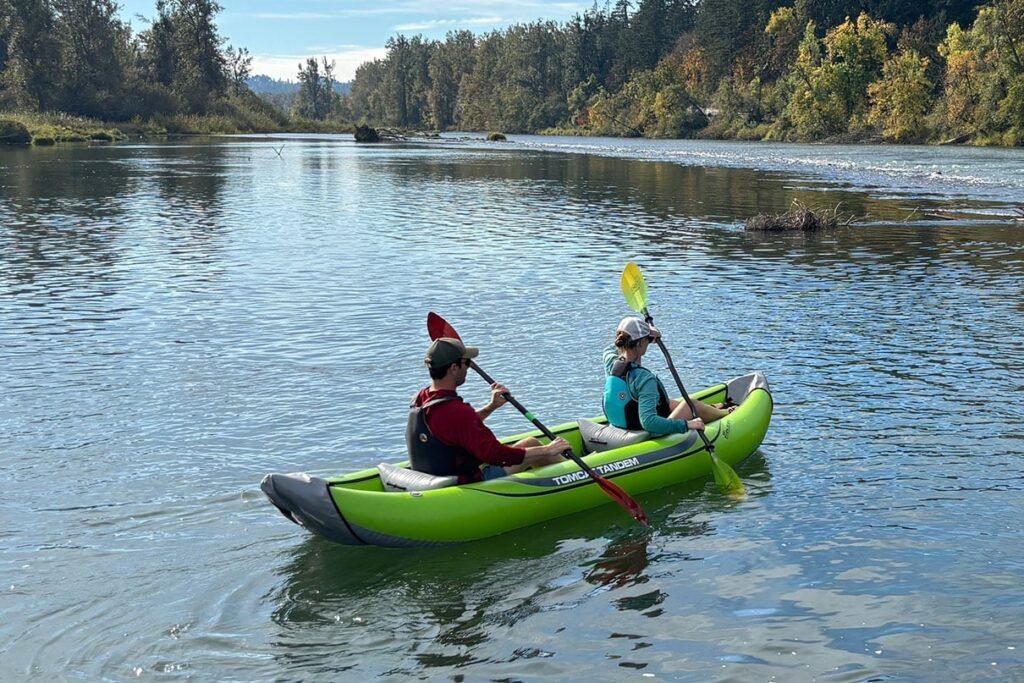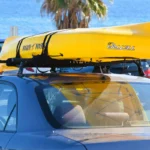Are inflatable kayaks good? That’s a question many new and even experienced paddlers ask when thinking about switching from a hard-shell kayak or trying kayaking for the first time. Inflatable kayaks are easy to carry, simple to store, and often more affordable—but can they really handle real-life use on lakes, rivers, or even the ocean? In this blog from Kayak Rumors, we’ll take a close look at inflatable kayaks and answer the questions that matter. We’re not here to sell you one—we’re here to give you the truth based on real experience and expert knowledge.
This guide covers what inflatable kayaks do well, where they struggle, and how they compare to hard-shell options. You’ll also learn how long they last, how safe they are, and what to consider before buying one. Everything is written in easy language, with real advice you can use. Whether you’re completely new to kayaking or just curious if an inflatable kayak fits your needs, you’re in the right place.
Benefits of Inflatable Kayaks Based on Real-World Use
Inflatable kayaks have grown in popularity for good reasons. They’re practical, affordable, and surprisingly strong. If you’re wondering why more people are choosing them over traditional kayaks, here’s what makes them stand out in real-world use:
Easy to Carry and Store
Inflatable kayaks can be deflated and rolled into a backpack-sized bag. No roof rack, trailer, or garage space is needed. You can keep it in your trunk, closet, or even take it on a bus or plane.
Lightweight but Strong
Most inflatable kayaks weigh much less than hard-shell models. Still, they’re built from durable materials like PVC, drop-stitch fabric, or reinforced rubber. Once inflated, many feel stable and solid under their weight.
More Affordable Than Hard-Shell Kayaks
If you’re on a budget, inflatable kayaks are a smart choice. Not only is the kayak itself usually cheaper, but you also save money by avoiding extra gear like roof racks or special storage solutions.
No Need for Special Transport
You don’t need a truck or SUV. A compact car is enough. Many paddlers even carry their kayak on foot to remote lakes or rivers. This opens up more paddling spots without worrying about logistics.
Comfortable for Long Trips
Inflatable models often come with padded seats, adjustable footrests, and softer surfaces. For many users, this makes them more comfortable during longer paddling sessions compared to rigid kayaks.
Versatile for Different Water Conditions
While they’re not made for heavy whitewater, inflatable kayaks work well on calm lakes, slow rivers, and mild coastal water. There are even models built for fishing or touring.
Low Maintenance with Good Durability
With basic care—like rinsing after use and keeping it dry before storage—inflatable kayaks can last for years. Punctures are rare, but easy to fix using patch kits that often come included.
Great for Beginners and Casual Users
If you’re new to kayaking or only paddle occasionally, inflatable kayaks make the experience simple and enjoyable. They’re stable, easy to manage, and take the stress out of storage and transport.
Limitations and Common Problems with Inflatable Kayaks
While inflatable kayaks offer many benefits, they’re not perfect. Just like any product, they have some drawbacks. It’s important to understand these before buying so you know what to expect and how to avoid common issues.
Risk of Punctures and Air Leaks
Even though most inflatable kayaks are made with tough materials, sharp rocks or branches can still cause small punctures. That said, minor damage is usually easy to fix with a patch kit. Carrying one with you is a smart move for longer trips.
Inflation and Deflation Take Time
Setting up an inflatable kayak takes a few minutes. You’ll need to pump it up, check the air pressure, and then secure parts like seats and footrests. It’s not hard, but it’s not instant either. Some people find it tiring if they don’t have an electric pump.
Less Control in Wind or Strong Currents
Inflatable kayaks sit a bit higher on the water and weigh less, so they can drift more in windy conditions. Tracking (keeping a straight path) may not be as precise as with a hard-shell kayak, especially without a skeg or fin.
Performance May Feel Softer
Some paddlers notice that inflatable kayaks feel less rigid when paddling fast or navigating choppy water. While high-end models reduce this issue with drop-stitch floors, casual users may still feel the difference.
Drying Before Storage Can Be Annoying
After a trip, you’ll need to rinse off sand or dirt and let the kayak dry fully before packing it up. Storing it while damp can cause mold or mildew. It’s not difficult, but it does add a few steps to your routine.
Weight Limits Can Be Restrictive
Each kayak has a specific weight capacity. Overloading it can affect how it floats and handles. If you’re planning to carry gear or paddle with another person, make sure your kayak is rated for the total weight.
Not Ideal for Rough Whitewater or Speed
If your goal is high-speed paddling or serious whitewater adventure, a hard-shell kayak might be a better fit. Inflatable models are better suited for casual or moderate use.
Understanding these limitations helps you use an inflatable kayak safely and enjoyably. In many cases, a bit of planning or the right accessories can reduce or solve these problems.
Are Inflatable Kayaks Safe and Reliable?
Safety is a big concern when it comes to any water sport. Many people wonder if inflatable kayaks can be trusted to keep them secure on the water. The good news is that, when used properly, inflatable kayaks are generally safe and reliable for a wide range of activities.
Built with Multiple Air Chambers for Extra Security
Most inflatable kayaks come with more than one air chamber. This design means that if one chamber gets damaged or loses air, the others keep you afloat. It’s a safety feature that adds peace of mind during your paddling adventures.
Stable and Balanced Designs
Inflatable kayaks often have wider bases than some hard-shell kayaks. This extra width provides better stability, especially for beginners or people who want a relaxing paddle. They’re less likely to tip over in calm to moderate waters, making them great for families or casual users.
Weight Limits and Proper Loading Matter
Every kayak has a maximum weight capacity, including the combined weight of paddlers and gear. Staying within these limits is important for safety and performance. Overloading can affect stability and increase the risk of capsizing.
Safety Gear and Precautions Are a Must
Like any water activity, using a personal flotation device (PFD) is essential. Inflatable kayaks don’t remove the need for basic safety equipment like life jackets, whistles, and helmets (in rougher conditions). Checking the weather and water conditions before heading out is equally important.
Real Experiences Show Reliable Performance
Many paddlers share stories about inflatable kayaks handling calm lakes, slow rivers, and even light ocean paddling without issues. When cared for properly, they hold air well and remain stable throughout the trip. Repair kits are handy but rarely needed on short, casual outings.
When Inflatable Kayaks May Not Be the Safest Option
For fast-moving rivers, heavy whitewater, or long ocean trips with strong waves, inflatable kayaks might not be the best choice. In these situations, a hard-shell kayak with reinforced structure and higher tracking ability offers better safety and control.
With the right preparation, inflatable kayaks can provide a safe and enjoyable experience. Understanding their limits and following basic safety practices helps ensure you stay secure on every paddle.
How to Choose a Good Inflatable Kayak
Choosing the right inflatable kayak can feel tricky, especially with so many options available. To help you make a smart choice, here are the key points to keep in mind before buying. These factors will ensure your kayak fits your needs and gives you the best experience on the water.
Material and Build Quality
Look for kayaks made from durable materials like high-grade PVC or drop-stitch fabric. These materials offer better resistance to punctures and wear. A well-constructed kayak will hold air longer and feel more stable when inflated.
Size and Weight Capacity
Make sure the kayak fits your body size and intended use. If you plan to paddle alone, a solo kayak around 9 to 12 feet is common. For two people, tandem kayaks 12 to 16 feet long work best. Always check the weight capacity and include your gear in the total.
Portability and Storage
If you need something easy to carry and store, choose a kayak that packs down small and is lightweight. Some models come with backpacks or carrying bags, which makes transport even simpler.
Type of Kayak for Your Activity
Think about how you want to use the kayak. For casual paddling on calm waters, a basic recreational kayak will do. If you want to fish, look for models with rod holders and extra storage. Touring kayaks offer better tracking and speed for longer trips.
Comfort Features
Check for adjustable seats and footrests. Comfortable seating helps on longer trips and reduces fatigue. Padded floors can add extra comfort and make your time on the water more enjoyable.
Brand Reputation and Reviews
Research brands known for quality and good customer support. Reading user reviews can give you a better idea of how a kayak performs in real conditions and how easy it is to set up or maintain.
Pump and Accessories Included
Many inflatable kayaks come with hand or electric pumps, repair kits, paddles, and carrying bags. Having these included can save you money and make your first use hassle-free.
Choosing the right inflatable kayak doesn’t have to be overwhelming. Keep these points in mind, and you’ll find a model that fits your budget, lifestyle, and paddling goals.
FAQs About Are Inflatable Kayaks Good
Here are answers to some of the most common questions people ask about inflatable kayaks. These should help clear up any doubts you might have and give you more confidence when considering one for yourself.
1. Are inflatable kayaks durable?
Yes, many inflatable kayaks are built to last. High-quality models use strong materials like reinforced PVC and drop-stitch fabric, which resist punctures and tears. With proper care, an inflatable kayak can last for several years.
2. Can I use an inflatable kayak in the ocean?
You can, but it depends on the model and conditions. Inflatable kayaks work well in calm coastal waters or small waves. However, they’re not designed for heavy surf or rough open water. Always check the kayak’s specifications and your skill level before heading to the ocean.
3. How long does it take to inflate and deflate an inflatable kayak?
Most inflatable kayaks take about 5 to 15 minutes to fully inflate with a hand pump. Electric pumps speed this up. Deflating and packing away usually takes around 10 minutes. It’s a bit of extra time compared to a hard-shell kayak, but manageable.
4. Which is better: inflatable or hard-shell kayaks?
It depends on your needs. Inflatable kayaks offer portability, affordability, and easy storage, making them great for casual paddlers. Hard-shell kayaks generally perform better in speed, tracking, and rough conditions, but require more space and transport
5. How do I store and maintain an inflatable kayak?
After use, rinse off dirt and salt with fresh water and let it dry completely. Store it in a cool, dry place away from direct sunlight. Avoid folding it the same way every time to prevent wear. Regularly check for leaks or damage and patch them promptly.
Last Words: Are Inflatable Kayaks a Smart Choice?
Are inflatable kayaks good? After looking closely at their benefits, limitations, safety, and how to pick the right one, it’s clear they’re a smart option for many paddlers. They offer convenience, comfort, and affordability that make kayaking more accessible. Whether you’re a beginner or someone who wants an easy way to explore calm waters, inflatable kayaks can deliver a satisfying experience.
Of course, they aren’t perfect for every situation. If you need a kayak for rough water or high-speed paddling, a traditional hard-shell kayak might be better. But for everyday use, easy transport, and hassle-free storage, inflatable kayaks shine. By understanding their strengths and being aware of their limits, you can choose a model that fits your lifestyle and enjoy your time on the water with confidence.
At Kayak Rumors, we believe inflatable kayaks have changed the way people get into paddling. They lower the barriers and invite more people to discover what kayaking has to offer. So if you’re wondering, “Are inflatable kayaks good?”—the answer is yes, as long as you pick the right one for your needs and care for it properly.



